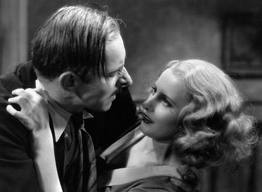 This was quite a common theme in Hollywood cinema of the 1930's, with the depression well under way, things were scarce. Jean Harlow had played a similar role in Jack Conway's Red-Headed Woman (1932). Of course this was exactly the kind of amoral characterisations that the Production code, often known as the Hays Code (after it's head Will Hays), was targeting as subversive and depraved for cinema audiences. The morality of the 1920's lingered for a short period into the Great Depression, which was seen by conservatives such as Hays, as a contributing part of the Wall Street crash.
This was quite a common theme in Hollywood cinema of the 1930's, with the depression well under way, things were scarce. Jean Harlow had played a similar role in Jack Conway's Red-Headed Woman (1932). Of course this was exactly the kind of amoral characterisations that the Production code, often known as the Hays Code (after it's head Will Hays), was targeting as subversive and depraved for cinema audiences. The morality of the 1920's lingered for a short period into the Great Depression, which was seen by conservatives such as Hays, as a contributing part of the Wall Street crash.With the progression of Powers through a succession of men within the bank, she inevitably leaves a line of men besotted with her. She becomes a kept woman by the head of the bank, and the confused and simple minds of the men are led to deceit. It's a terrifically twisted plot, but also it does not necessarily give the femme fatale her deserved conclusion. But she does learn the importance of people over the accumulation of material wealth - perhaps the perfect end to decadence in poverty stricken '30's America.
Directed by: Alfred E. Green
Starring: Barbara Stanwyck, George Brent, Donald Cook, Alphonse Ethier
Country: USA
Rating: ****
Marc Ivamy


No comments:
Post a Comment